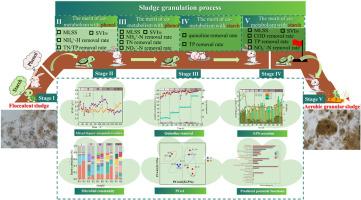碳源类型对好氧颗粒污泥系统构建及其对喹啉的去除的影响:淀粉与苯酚之间的乌龟赛跑
IF 8.4
2区 环境科学与生态学
Q1 ENVIRONMENTAL SCIENCES
引用次数: 0
摘要
煤化工废水中含有高浓度的喹啉、苯酚等有毒有机污染物。已知好氧颗粒污泥(AGS)中的微生物可以有效地降解有机物。本研究系统比较了以常见碳源淀粉(R1)和有毒碳源苯酚(R2)为共代谢底物的喹啉降解好氧颗粒污泥的培养特性。结果表明,低喹啉浓度(30 mg/L)时,R2更有利于改善污泥的沉降性、生物量保持和喹啉降解菌的生长。然而,随着喹啉浓度的增加,淀粉培养的颗粒污泥最终在沉降性能、生物量和污染物去除方面优于苯酚作为共同代谢底物。对典型运行周期污染物降解特性的分析表明,将喹啉降解到5.5 mg/L左右所需的时间在R1中为150 min,在R2中为420 min,表明R1中的反应速率更高。在两个反应器中,均鉴定出Acidovorax为主要的喹啉降解菌。此外,微生物差异分析和功能基因显示R1的细菌分化更为明显,富集于厚壁菌门和Deinococcaceae。与喹啉降解相关的酶的相对丰度在R1中较高。本文章由计算机程序翻译,如有差异,请以英文原文为准。

Behavior of carbon source type on the construction of aerobic granular sludge system and its removal of quinoline: A tortoise and hare race between starch and phenol
Coal chemical wastewater contains high concentrations of toxic organic pollutants such as quinoline and phenol. Microorganisms in aerobic granular sludge (AGS) are known to efficiently degrade organic matter. This study systematically compared the cultivation characteristics of quinoline-degrading aerobic granular sludge using starch (R1), a common carbon source, and phenol (R2), a toxic carbon source, as co-metabolizing substrates. The results indicated that R2 was more conducive to improving sludge settleability, biomass retention, and the growth of quinoline-degrading bacteria when a low quinoline concentration (30 mg/L) was applied. However, as the quinoline concentration increased, the granular sludge cultured with starch eventually outperformed phenol as a co-metabolizing substrate in terms of settling performance, biomass, and pollutant removal. Analysis of the pollutant degradation characteristics during a typical operation cycle revealed that the time required to degrade quinoline to approximately 5.5 mg/L was 150 min in R1 and 420 min in R2, indicating a higher reaction rate in R1. Acidovorax was identified as the dominant quinoline-degrading bacterium in both reactors. In addition, microbial differential analysis and functional genes indicated more pronounced bacterial differentiation in R1, enriched in Firmicutes and Deinococcaceae. the relative abundance of enzymes associated with quinoline degradation was higher in R1.
求助全文
通过发布文献求助,成功后即可免费获取论文全文。
去求助
来源期刊

Journal of Environmental Management
环境科学-环境科学
CiteScore
13.70
自引率
5.70%
发文量
2477
审稿时长
84 days
期刊介绍:
The Journal of Environmental Management is a journal for the publication of peer reviewed, original research for all aspects of management and the managed use of the environment, both natural and man-made.Critical review articles are also welcome; submission of these is strongly encouraged.
 求助内容:
求助内容: 应助结果提醒方式:
应助结果提醒方式:


